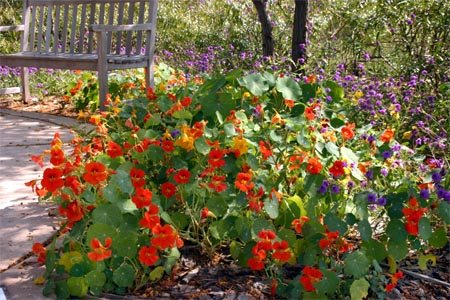
Nasturium is an easy-to-grow, warm-season annual (perennial in zones 9 -11) with distinctive leaves and brightly colored flowers. Nasturtium is the common name of Tropaeolum majus. It is one species in a genus of about 80 species of annual and perennial herbaceous flowering plants in the family Tropaeolaceae native to South America and Central America, from Mexico to Chile. This common name refers to the fact that it has a mustard oil similar to that produced by watercress (Nasturtium officinale, family Brassicaceae). Early English herbalists referred to nasturtiums as “Indian cress” after the conquistadors discovered them in the jungles of Peru and Mexico and brought them back to Spain in the 16th century.
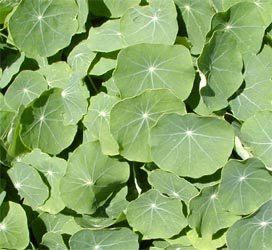
The peltate (shield-shaped) or nearly circular, deep green leaves have light-colored veins radiating from the central petiole. Leaves can be quite large, up to 4’ across on some plants. Many types have flat, round leaves reminiscent of water lily pads. There are some cultivars that have variegated, almost speckled, leaves. Depending on the variety, the plant either forms a low mound or trails up to 3 feet.
The intensely colored flowers traditionally were bright yellow and orange but now the flowers come in many different shades of red, yellow, orange, and cream in both rich, saturated jewel-toned colors and more muted pastels.
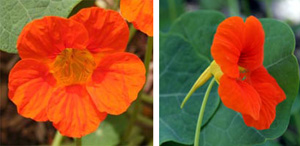
Most are a single color but some varieties are lightly marked with a second color towards the center. They normally have five petals and a funnel-shaped nectar spur in the back. The flowers spread to more than 2½” wide. The plants produce 3-segmented fruit, each portion with a single large seed. Plants will self-seed readily. In warm climates, it blooms and seeds all year round and is considered invasive in many of those areas.
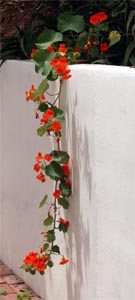
Nasturtiums are a welcome addition to any sunny garden, particularly those with an informal design. Monet planted them in the border of the pathway that led to the front door of his home in Giverny, France. The compact varieties remain about 12″ tall, making them well suited for edging. The rambling habit of trailing types make them useful in hanging baskets and window boxes or cascading down walls. They can also be grown as a groundcover and will climb up shrubs, trees, or a trellis to get more sun. Both types of nasturtiums can be included in mixed containers but may have to be trimmed back periodically to prevent them from crowding out the other plants. They can also be used to fill in blooming gaps among complementary colored day lilies and roses.
Plant nasturtiums in well-drained soil in full sun. They will grow in partial shade but will not bloom well under those conditions. Sow seed directly in the garden in late spring to early summer once all danger of frost has passed or start indoors in peat pots 4-6 weeks before the average date of last frost.
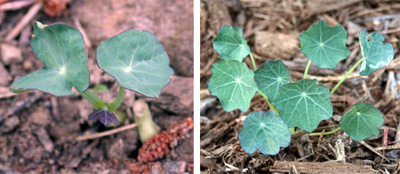
Sow seeds ½” deep (they need darkness to germinate) and 10-12” apart. Soak the seed overnight to enhance germination. They should come up in a week to ten days depending on the soil temperature. Do not fertilize, except on extremely poor soil, as fertilization will promote leaf growth and suppress flowering. Deadheading or picking the flowers will prolong blooming. Nasturtium will continue blooming until frost. Although they like dry soils and will tolerate drought, water them during the entire growing season to keep them blooming.
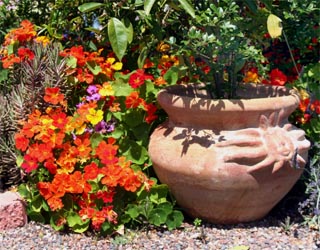
Nasturtium has few pests; the most common insect pest is the imported cabbageworm (Pieris rapae) and aphids. Leafminers often make serpentine trails on the leaves but this doesn’t damage the plant.
Nasturtium flowers and leaves are edible and make an attractive addition to salads. They have a slightly peppery taste reminiscent of watercress, with a spicier flavor when grown in sunnier, hotter weather. They taste better when young; older leaves can be bitter. The flowers are less intensely flavored than the leaves.
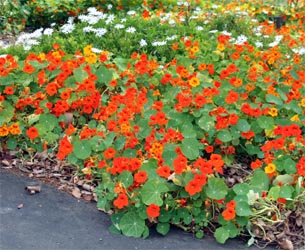
Some readily available cultivars include:
-

Nasturtium ‘Alaska’
‘Alaska’ series – heavily variegated leaves (green mottled with creamy white) on bushy plants with bright single flowers in a variety of colors held above the foliage. - ‘Black Velvet’ – deep maroon flowers.
- ‘Empress of India’ – brilliant single crimson red flowers and dark, purplish foliage. A classic compact variety that is good in pots.
- ‘Gleam’ – double flowers in a mix of colors on semi-trailing plants about 12” tall.
- ‘Jewel’ series – bushy, dwarf plants with double and semi-double flowers in red, pink, yellow and orange. Unusual fluted petals add interest to containers.
- ‘Jewel of Africa’ – a trailing type with variegated leaves.
- ‘Peach Melba’ – has semi-double yellow flowers with a red-orange throat. It is a dwarf plant that is good in containers.
- ‘Tip Top’ series – an improved ‘Alaska,’ with mottled and spotted leaves and bright flowers in yellow, red and orange.
- ‘Tom Thumb’ series – a shorter (6-9”) type with large, vivid blooms in bright yellow, red and orange. A good choice for smaller gardens.
- ‘Vesuvius’ – brilliant deep orange flowers on compact plants.
- ‘Whirlybird’ series – compact, mid-green plants (9-12”) with semi-double flowers in shades of orange, yellow, salmon, deep mahogany and rose. The ruffled flowers lack the typical flower spur so they sit flat on the tops of the stems.
- ‘Canary Creeper’ is actually a different species (T. peregrinum) that is a perennial vine in zones 9-11 or grown as an annual. It has bright yellow, fringed flowers that look somewhat like bird’s wings and 5-lobed, light green leaves. It is very fast growing.
– Susan Mahr, University of Wisconsin – Madison





 Marigolds
Marigolds Create a Butterfly Garden
Create a Butterfly Garden Plant Flowers to Encourage Beneficial Insects
Plant Flowers to Encourage Beneficial Insects Forcing Bulbs
Forcing Bulbs


